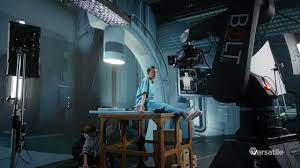
Welcome to the new year — and to some of the biggest moviemaking plot twists of 2024. In this continuing series we’re highlighting the products, trends, and businesses changing the process of making movies in ways no one saw coming just a few years or even months ago. Today: Virtual production.
We previously showcased the increasing availability of LED Volume screens, and virtual production and Volume screens go hand in hand. Volumes use recent video game graphics simulator Unreal Engine to render epic 3D, CGI worlds in real time, which allows actors to actually be immersed in that scenery while filming — and for cameras to capture it all seamlessly at once.
Feeding the Volume revolution even further is an entire virtual production workflow, including virtual location scouting, 3D environment scanning, Unreal environment building, performance motion capture, real-time rendering, on-set sequence editing, A.I. computing power, and motion-control robotics — all now accessible to independent productions through companies like Vū, as well as Vancouver-headquartered Versatile Media.
The company recently shot the sci-fi film New Air, combining virtual production and one of Versatile’s LED Volume screens, in just 10 days.
“Our strategy and our hope for the future of filmmaking is that we bring the level of independent films and productions up a notch,” Versatile Media business development executive Roula Lainas tells MovieMaker.
“We really feel there is a really great market for indie films that have been left out of this opportunity with studios; you’re either making Marvel’s $100 million movies that are so VFX heavy, or these $1 million indie films. There is that $10 to $15 million range of truly indie films that we believe have the opportunity with our virtual production technology to be made and raise the bar.”
Virtual Production in Practice
Virtual production begins with directors, cinematographers and producers using these tools during the pre-visualization stage, which goes far beyond simple storyboarding. Now, for about 1 percent of the overall budget, key creatives have the ability to imagine, plan and even execute shots with immediate visualization, utilizing in-camera 3D environment rendering and performance motion capture.
Essentially, each scene is animated before it is even shot with the actors, giving filmmakers the freedom to experiment with shot angles, animation, in-frame composition and lighting, so they can make the most out of production days, while still having the ability to switch things up on the fly with the support of in-house virtual production experts who make it all possible.
Main image: A scene from “New Air.”
Share:

